Quilt No.1000GB - Giuliana Bond
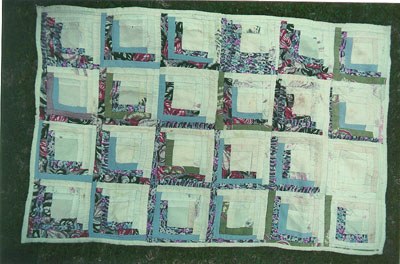
Quilt was made by Leonilde Palandri (born Vignaroli) in 1959, in Margaret River, WA. She gave the quilt to her grand-daughter, the present owner, as a gift for her three-week old son, Kim. The quilt is not used.
"Kim's Cot Quilt. My eldest son Kim was born in November 1959 and my grandmother Leonilde Palandri nee Vignaroli presented me with this quilt when Kim was three weeks old. She must therefore have constructed the quilt in the few months before his birth. Leonilde was then 67 years old. She and my grandfather Giacomo were still living on the family farm in an extended family situation. By then the farm was being run by my uncle Giueseppe, his wife Atilia and their family. My grandparents were however, still very active and they both assisted in the work of running the farm and in the household work.
Leonilde was the third child of Luigi Vignaroli and Annunziata Manatini. She was born at Piandelagotti, a small mountain village in the northernmost part of the Italian Apennines. Very close to the Alps! She went into service in her mid teens and it is possible that she learnt her needlework skills whilst in service. All her life she continued to be a keen and highly skilled needleworker. Her embroidery and her fine crochet work were mostly original in design, and always very attractive, and often very unusual.
She was a very assertive and independent person and for many years she ran her own business in her home town of Savoniero where she and grandfather had built a house and bought some land and a business in the town. While Leonilde ran the business (an Osteria) and had the land worked and looked after her family of a daughter (my mother Gemma) and her two sons Giuseppe and Carlo, my grandfather worked abroad to earn money, first to build the house and later to help expand the business.
Eventually though, Giacomo and Leonilde made the decision to emigrate permanently to Australia. I have always thought that the signs of a developing European conflict must have helped to make up their minds. However, during the last year documents have available to me which show that both Giacomo and Leonilde were already British citizens by naturalisation before he applied for his family to come to Australia. This puzzles me.
Leonilde and her two sons came to Australia in 1940 on one of the last ships to come from Italy to Australia. They went to Margaret River in the south west of Western Australia where my grandfather had bought a block of heavily timbered land which he intended to clear for dairy farming. Leonilde and Giacomo lived in a two roomed house made of sleepers and the two teenage boys Guiseppe and Carlo slept in a tent which they had erected beside the 'house'. During those first few months the two boys helped to construct another room onto the sleeper house for use as their bedroom. At this time Giacomo worked on contract, cutting timber for the local timber mills. He employed men to cut down the trees and make them into sleepers and he carted these sleepers on his 'International' truck. He continued this work until he and his sons had cleared sufficient land for him to run milking cows on the farm. In the meantime both Giuseppe and Carlo had obtained work with local farmers and later in one of the local timer mills.
At the end of World War Two Giacomo and his family built a house from the local granite. Building materials were very scarce at that time and so only the basic plan of the house was implemented. Verandas which were part of the original design were not added until later. The basic house, as I first saw it was completed sometime in 1948.
During all of these years Leonilde who was 48 years old at the time of her arrival had worked alongside Giacomo and their sons clearing the land and making a comfortable home for them, albeit in a 'sleeper house'. She had been busy with her needle too, and because fabrics and threads were scarce during the war years, she often embroidered on calico from sugar and flour bags, and crocheted with the threads she unravelled from the sugar and flour bags. When I first went to live with my grandparents in 1949, my grandmother had drawers full of beautiful embroidery which she had worked. She was still as busy as ever with her needle, and, as well as her embroidery and Log Cabin style quilts, she made colourful mats for her house by folding squares of fabric and stitching them in overlapping rows on a canvas backing. These were constructed in the style of what we know as 'prairie points'. She also created another kind of patchwork by joining circles or squares of embroidered fabrics together with crochet. Later in life when she found patchwork and embroidery too demanding on her eyes and arthritic hands, she made coverlets from knitted and crocheted squares.
Leonilde was a gifted and creative needleworker who used a variety of media in her textile art and crafts, and whose passion for this art was transmitted to her daughter and at least three of her grand-daughters. We, in turn, through teaching, have passed these skills on to many more people, and in this way Leonilde has made a big contribution to textile arts in Australia." [Giuliana Bond]
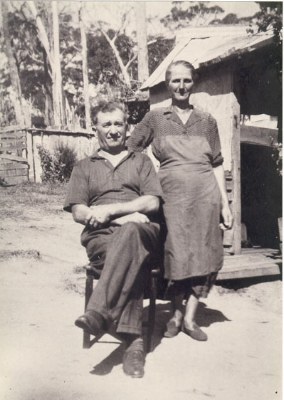
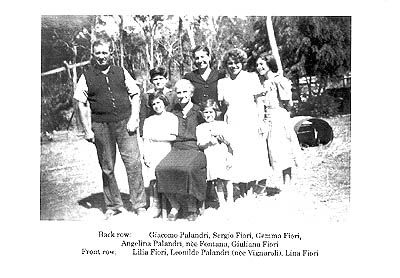
Front row: Lilia Fiori, Leonilde Palandri (born Vignaroli), Lina Fiori
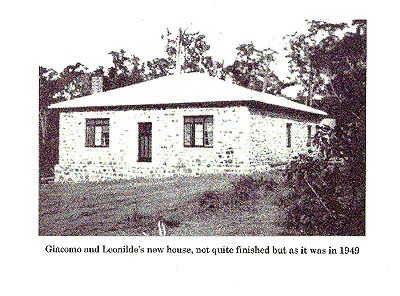
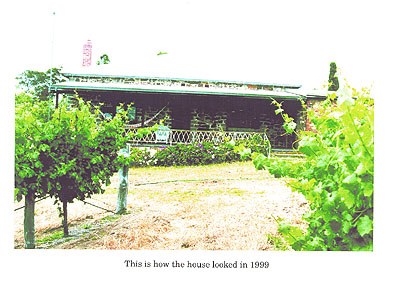
Related Quilts:
The quilt is of three layers because the strips of the log cabin are attached to a backing piece, and then the quilt is lined; however it is not padded." [NGA]
1400 x 930mm
Quilt is hand pieced.
1000 x 1000mm
1710 x 1600mm
760 x 660mm






